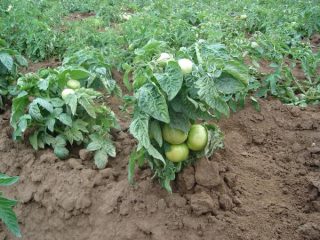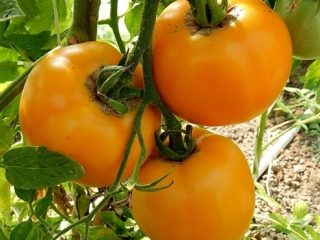Content
Most tomato varieties belong to the category of vegetable crops that exhibit a high level of resistance to infectious diseases. However, sometimes gardeners notice that gray rot has appeared on tomatoes. To take effective measures to prevent the disease and get rid of its consequences, it is necessary to have an understanding of the nature and conditions of the spread of infection.

Gray mold quickly spreads to tomatoes growing in close proximity
What kind of disease is this
Gray rot (late blight) is a dangerous fungal disease that affects fruit crops, including tomatoes. The causative agent of the infection is carried by air currents, infecting vegetable plantings with rot. Another way the fungus spreads is through water. Gray mold spores that persist in the soil for several years fall on plants during watering.
Reasons for appearance
It has been noticed that gray rot usually appears after planting tomatoes. During the procedure, wounds are formed, which under normal conditions do not pose a threat to plants. But if pathological microorganisms enter the structure of the tomato bush, then infection with gray rot occurs. Adverse weather factors accelerate the development of the disease.
The following have a negative impact:
- decrease in temperature;
- high humidity;
- air circulation disturbance.
The problem is aggravated by the presence of fallen leaves and fruits. The spread of gray rot is facilitated by swampy areas and high acidity of the soil.
Gray rot on tomatoes in a greenhouse is a fairly common occurrence. Greenhouse plants are infected more often than vegetables growing in beds. When growing tomatoes in greenhouses, there are two factors that contribute to the development of infection:
- Cramped growing conditions.
- Insufficient fresh air flow and high humidity.
Spores develop best at temperatures from +5 0From to +40 0C. The optimal air humidity for pathological processes is above 80%. Failure to disinfect the greenhouse also contributes to the spread of gray mold.

Microorganisms from the genus of saprophytes, which include gray rot, also infect onions, cucumbers, beets, and potatoes
Signs of the disease
Regular monitoring of tomato plantings makes it possible to identify the disease at the initial stage. Signs of the disease are found near the damage that occurred after the removal of the stepsons.Initially, a whitish spot forms on the stems and leaves of the tomato.
After a few days, a characteristic gray coating appears - fungal spores. Subsequently, the spots occupy an increasingly larger area, and the color of the formations changes from gray to brown. The fruits become soft.
How dangerous is the disease?
Tomato stems that are injured during pinching are the most affected by gray rot. Nodes form inside the tissue, and capillary necrosis develops. As a result, water stops flowing, which leads to wilting. At the final stage, the fungus destroys the plant completely. Yellow spots form on unripe fruits. Subsequently, the entire tomato is covered with plaque. Gray rot on tomatoes in a greenhouse looks very unpleasant.

The pulp under the spots softens and rots, causing the fruits to become inedible
How and with what to treat gray rot on tomatoes
Experienced gardeners are confident that if you treat tomatoes from the moment the first signs of gray rot are detected, then the negative consequences can be overcome. When there is massive damage to plantings, it is extremely difficult to cope with the infection.
Agrotechnical methods
In fact, agricultural methods are more aimed at preventing the disease than at treating it.
Among the effective agricultural techniques:
- Compliance with the watering regime. Tomatoes require abundant but not frequent watering.
- Loosening the soil after watering.
- Using a sharp knife when performing pinching. The tool requires pre-processing.
- Weeding of weeds, which often become a breeding ground for gray rot.
- Cleaning leaves, shoots and stepsons after the stepsoning procedure.
When watering plants, you should direct the stream of water under the root, avoiding irrigating the leaves and fruits.It is especially important to follow this rule when caring for tomatoes in greenhouses or greenhouses, where the humidity level is always higher than in open garden areas.
Folk remedies
At an early stage of the disease, you can do without chemicals. To combat the emerging gray mold, means from the arsenal of folk experience are used. The advantage of compositions based on recipes developed over centuries of practice is safety for humans and beneficial inhabitants of the garden plot (birds, bees, etc.). The following are effective in eliminating gray rot on tomatoes:
- Laundry soap solution. To prepare it, 100 g of soap shavings are diluted in a bucket with hot water. The cooled solution is poured over the bushes affected by gray mold so that a soapy film forms on them, inhibiting the proliferation of fungal spores.
- Boric acid. To prepare a 1% solution, you will need 1 g of boric acid per bucket of water. A simple folk remedy prevents the spread of infection, stimulates the formation of shoots and ovaries, and strengthens the immune system.
- Baking soda. A solution of soda is used to spray tomato bushes. According to the recipe, 10 liters of water require 100 g of soda.
Instead of laundry soap, you can use green soap to eliminate gray rot. The solution will require 80 g of liquid soap (or shavings) per 10-liter bucket of water.
Chemical preparations for gray rot
When the infectious process is advanced, it is advisable to use chemicals. If gray rot is detected on tomatoes, the bushes can be treated with one of the following products:
- Profit;
- Ditan;
- Integral;
- Fundazol;
- Speed;
- Abiga Peak;
- Oxycom;
- Bordeaux mixture.
All synthetic preparations for the destruction of gray mold are recommended to be used in accordance with the attached instructions. Otherwise, instead of healing the plants, they can be destroyed. It is recommended to re-treat no earlier than ten days later.

Chemicals used to combat gray mold are toxic and therefore prohibited during the harvest period
Biological products
Biological products are highly effective in eliminating gray rot. The following compositions successfully destroy the fungus:
- Fundazol. The components included in its composition suppress the development of spores and at the same time fight the larvae of harmful insects. Fundazol is used both for the prevention of fungal infections and in the treatment of tomatoes against plant mycoses.
1 g of Fundazol is diluted in 1 liter of water and the solution is sprayed on plants infected with gray rot
- Maksim. A popular fungicide among gardeners and farmers, it kills spores, suppressing the infection in 3-4 days. A significant plus is the ability to spray greenhouse plants during the formation of buds.
When preparing a solution of Maxim, 4 ml of the drug is diluted in 10 liters of water
- Agate 25K. The action of the biological product is aimed at suppressing pathogenic microflora and strengthening the immunity of fruit crops. At the initial stage of mycoinfection development, the bushes are treated with Agat 25K solution at the rate of 50 ml per 1 liter of water.
Agat 25K can be used up to three times per season, as it does not accumulate in fruits
The biological products Gliokladin, Trichodermin, Zerox have proven themselves to be excellent. When planning processing, you should take into account that the substances contained in biological products lose their properties when exposed to sunlight.Agricultural technicians recommend spraying on cloudy days or in the evening.
How to get rid of gray rot on tomatoes in a greenhouse
As already noted, the fight against mycoinfection in enclosed spaces has its own characteristics due to the high crowding of plants and high levels of humidity. Gray rot on tomatoes in the greenhouse develops intensively (see photo). In an isolated space, to cure tomatoes from gray rot, it is preferable to use folk remedies and biological preparations, since chemical compounds accumulate in the plant structure in the absence of a constant flow of air and high humidity.

Methods of combating infection in greenhouses are identical to those used when growing crops in open ground
How to prevent gray rot on tomatoes
Like any disease, gray rot is easier to prevent than to cure. Measures to prevent the development of infection in tomato and other vegetable crops include:
- timely implementation of agrotechnical procedures (watering, loosening);
- pinching taking into account sanitary measures, which includes the destruction of damaged and removed shoots;
- carrying out disinfection work in the greenhouse at the end of the winter period;
- regular ventilation of greenhouses and greenhouses after watering.
It is equally important to purchase planting material from trustworthy places. Also, when growing seedlings at home, it is advisable to use soil that has been disinfected.

To disinfect instruments when pinching, alcohol-containing substances and aniline dyes are used.
Resistant varieties
Breeders are working to create tomato varieties resistant to gray rot. There are varieties of tomatoes that exhibit relative resistance to infection. In this regard, there are varieties of tomatoes that grow well in greenhouse conditions and in open ground:
- Vasilevna;
- Pilgrim.
Special requirements apply to tomato varieties grown in greenhouses. The following hybrids are recommended for cultivation in greenhouses:
- Bohemia F1;
- Ural F1;
- Firebird F1;
- Charisma F1;
- Vologda F
These varieties are resistant to many types of infections, including gray rot. In addition, according to gardeners, hybrid forms of tomatoes are capable of producing a good harvest when there is a lack of sunny color.
Conclusion
Gray rot on tomatoes can ruin the crop and create unfavorable conditions for gardening in the future. But existing methods of prevention and treatment make it possible to cope with the problem. The choice of method to combat infection remains with the owner of the garden plot.











